外研版英语七年级下M5U1说课稿培训讲学
- 格式:doc
- 大小:19.50 KB
- 文档页数:7

七年级英语下册 Module 5 Unit 1 What can I do for you说课稿(外研版)一. 教材分析《七年级英语下册 Module 5 Unit 1 What can I do for you》是人教版英语教材的一个组成部分。
本节课主要介绍日常生活中的服务场所和相应服务用语。
通过本节课的学习,学生可以掌握有关服务场所的词汇,如hotel, restaurant, post office 等,以及常用的服务用语,如What can I do for you, Here you are等。
同时,学生还可以通过本节课的学习,提高自己的交际能力,学会在不同的服务场所进行有效的沟通。
二. 学情分析七年级的学生已经具备了一定的英语基础,能够听懂并运用一些基本的英语口语。
但他们在词汇量和语法知识方面还存在一定的局限性,对一些服务场所和服务用语的认知还不够清晰。
因此,在教学过程中,需要注重词汇的引入和巩固,以及交际场景的模拟和实践。
三. 说教学目标1.知识目标:学生能够掌握有关服务场所的词汇,如hotel, restaurant,post office等,以及常用的服务用语,如What can I do for you, Here you are 等。
2.能力目标:学生能够熟练运用所学词汇和句型,在不同的服务场所进行有效的沟通。
3.情感目标:培养学生对英语学习的兴趣,增强他们的自信心,使他们更加积极地参与课堂活动。
四. 说教学重难点1.重点:掌握有关服务场所的词汇和常用的服务用语。
2.难点:在实际交际中灵活运用所学知识,提高交际能力。
五. 说教学方法与手段1.情境教学法:通过模拟不同的服务场所,让学生在实际语境中学习并运用所学知识。
2.交际法:引导学生进行角色扮演,提高他们的口语交际能力。
3.任务型教学法:通过完成各种任务,让学生在实践中巩固所学知识。
4.多媒体教学手段:利用多媒体课件,为学生提供丰富的视觉和听觉信息,增强课堂趣味性。
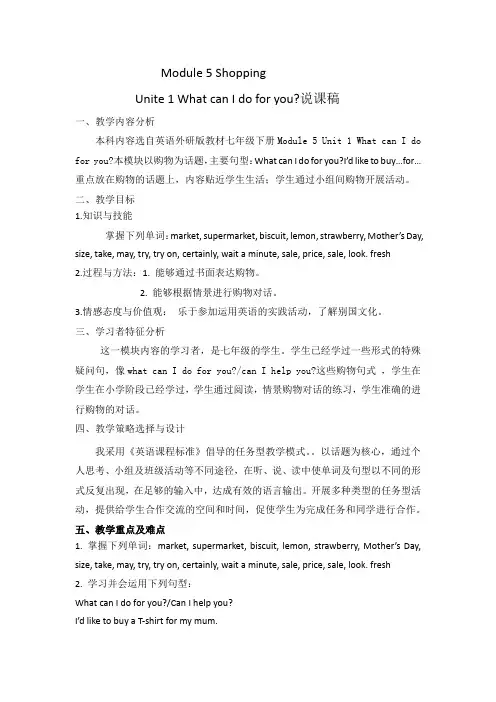
Module 5 ShoppingUnite 1 What can I do for you?说课稿一、教学内容分析本科内容选自英语外研版教材七年级下册Module 5 Unit 1 What can I do for you?本模块以购物为话题,主要句型:What can I do for you?I’d like to buy…for…重点放在购物的话题上,内容贴近学生生活;学生通过小组间购物开展活动。
二、教学目标1.知识与技能掌握下列单词:market, supermarket, biscuit, lemon, strawberry, Mother’s Day, size, take, may, try, try on, certainly, wait a minute, sale, price, sale, look. fresh2.过程与方法:1. 能够通过书面表达购物。
2. 能够根据情景进行购物对话。
3.情感态度与价值观:乐于参加运用英语的实践活动,了解别国文化。
三、学习者特征分析这一模块内容的学习者,是七年级的学生。
学生已经学过一些形式的特殊疑问句,像what can I do for you?/can I help you?这些购物句式,学生在学生在小学阶段已经学过,学生通过阅读,情景购物对话的练习,学生准确的进行购物的对话。
四、教学策略选择与设计我采用《英语课程标准》倡导的任务型教学模式。
以话题为核心,通过个人思考、小组及班级活动等不同途径,在听、说、读中使单词及句型以不同的形式反复出现,在足够的输入中,达成有效的语言输出。
开展多种类型的任务型活动,提供给学生合作交流的空间和时间,促使学生为完成任务和同学进行合作。
五、教学重点及难点1. 掌握下列单词:market, supermarket, biscuit, lemon, strawberry, Mother’s Day, size, take, may, try, try on, certainly, wait a minute, sale, price, sale, look. fresh2. 学习并会运用下列句型:What can I do for you?/Can I help you?I’d like to buy a T-shirt for my mum.What color does she like?What size does she take?May I try it on?There is a sale on today.Everything is half price.How much are they?What else would you like?六、教学过程[课前朗读]: 组长领读单词,并了解汉语意思,养成学生自主学习词汇的习惯,促使学生迅速进入学习状态。
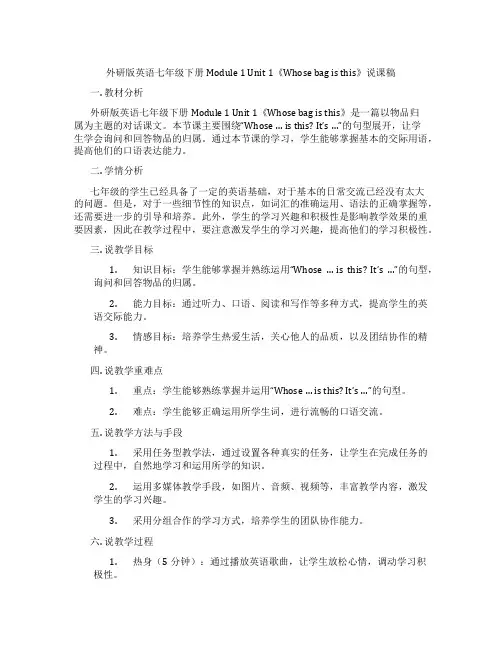
外研版英语七年级下册Module 1 Unit 1《Whose bag is this》说课稿一. 教材分析外研版英语七年级下册Module 1 Unit 1《Whose bag is this》是一篇以物品归属为主题的对话课文。
本节课主要围绕“Whose … is this? It’s …”的句型展开,让学生学会询问和回答物品的归属。
通过本节课的学习,学生能够掌握基本的交际用语,提高他们的口语表达能力。
二. 学情分析七年级的学生已经具备了一定的英语基础,对于基本的日常交流已经没有太大的问题。
但是,对于一些细节性的知识点,如词汇的准确运用、语法的正确掌握等,还需要进一步的引导和培养。
此外,学生的学习兴趣和积极性是影响教学效果的重要因素,因此在教学过程中,要注意激发学生的学习兴趣,提高他们的学习积极性。
三. 说教学目标1.知识目标:学生能够掌握并熟练运用“Whose … is this? It’s …”的句型,询问和回答物品的归属。
2.能力目标:通过听力、口语、阅读和写作等多种方式,提高学生的英语交际能力。
3.情感目标:培养学生热爱生活,关心他人的品质,以及团结协作的精神。
四. 说教学重难点1.重点:学生能够熟练掌握并运用“Whose … is this? It’s …”的句型。
2.难点:学生能够正确运用所学生词,进行流畅的口语交流。
五. 说教学方法与手段1.采用任务型教学法,通过设置各种真实的任务,让学生在完成任务的过程中,自然地学习和运用所学的知识。
2.运用多媒体教学手段,如图片、音频、视频等,丰富教学内容,激发学生的学习兴趣。
3.采用分组合作的学习方式,培养学生的团队协作能力。
六. 说教学过程1.热身(5分钟):通过播放英语歌曲,让学生放松心情,调动学习积极性。
2.导入(10分钟):教师展示一些物品,引导学生用中文描述物品的归属,然后过渡到英文描述,引出本节课的主题。
3.呈现(10分钟):教师通过展示图片和实物,引导学生用英文询问和回答物品的归属。
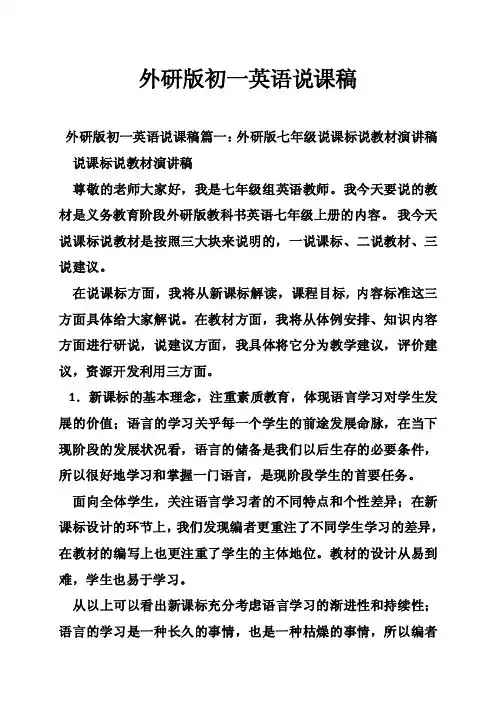
外研版初一英语说课稿外研版初一英语说课稿篇一:外研版七年级说课标说教材演讲稿说课标说教材演讲稿尊敬的老师大家好,我是七年级组英语教师。
我今天要说的教材是义务教育阶段外研版教科书英语七年级上册的内容。
我今天说课标说教材是按照三大块来说明的,一说课标、二说教材、三说建议。
在说课标方面,我将从新课标解读,课程目标, 内容标准这三方面具体给大家解说。
在教材方面,我将从体例安排、知识内容方面进行研说,说建议方面,我具体将它分为教学建议,评价建议,资源开发利用三方面。
1.新课标的基本理念,注重素质教育,体现语言学习对学生发展的价值;语言的学习关乎每一个学生的前途发展命脉,在当下现阶段的发展状况看,语言的储备是我们以后生存的必要条件,所以很好地学习和掌握一门语言,是现阶段学生的首要任务。
面向全体学生,关注语言学习者的不同特点和个性差异;在新课标设计的环节上,我们发现编者更重注了不同学生学习的差异,在教材的编写上也更注重了学生的主体地位。
教材的设计从易到难,学生也易于学习。
从以上可以看出新课标充分考虑语言学习的渐进性和持续性;语言的学习是一种长久的事情,也是一种枯燥的事情,所以编者在编写我们的教材的时候,更加充分的考虑了它的渐进性和持续性,从贴近生活的话题,到循序渐进的语法知识点,更好的培养了学生学习一门语言的兴趣。
强调学习过程,重视语言学习的实践性和应用性;我们新目标英语教材在编写的过程中,更大的注重了学生学习的实用性和应用型,贴近生活的话题,让学生能从学习的过程中感到乐趣,教材设计的听说读写的环节,体现了语言的实用性。
优化评价方式,着重评价学生的综合语言运用能力;在学生学习英语的过程中,很好的评价方式对于一个学生的学习有着至关重要的作用。
那么在评价方面,我们可以着重看中学生的语言综合运用能力,培养他们语言的感知力和对语言的认识度。
丰富课程资源,拓展英语学习渠道。
在我们新课标英语教材的设计编排上,我们给学生配备了配套的磁带,CD,等等这些丰富的课程资源,更大的拓展了学生学习英语的方法和途径。
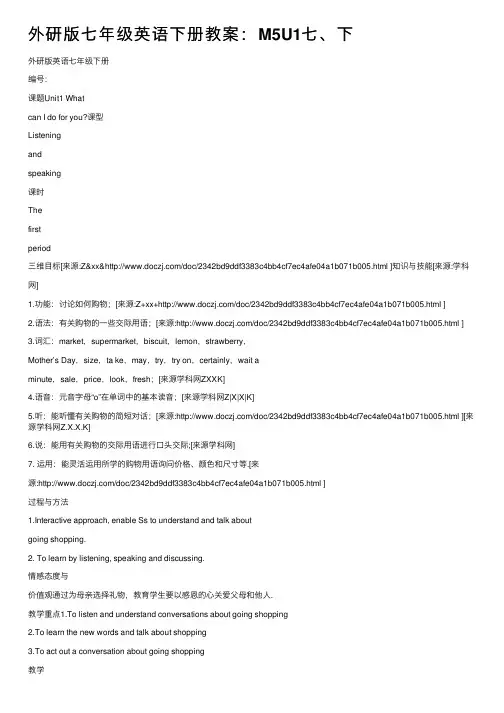
外研版七年级英语下册教案:M5U1七、下外研版英语七年级下册编号:课题Unit1 Whatcan I do for you?课型Listeningandspeaking课时Thefirstperiod三维⽬标[来源:Z&xx&/doc/2342bd9ddf3383c4bb4cf7ec4afe04a1b071b005.html ]知识与技能[来源:学科⽹]1.功能:讨论如何购物;[来源:Z+xx+/doc/2342bd9ddf3383c4bb4cf7ec4afe04a1b071b005.html ]2.语法:有关购物的⼀些交际⽤语;[来源:/doc/2342bd9ddf3383c4bb4cf7ec4afe04a1b071b005.html ]3.词汇:market,supermarket,biscuit,lemon,strawberry,Mother’s Day,size,ta ke,may,try,try on,certainly,wait aminute,sale,price,look,fresh;[来源学科⽹ZXXK]4.语⾳:元⾳字母“o”在单词中的基本读⾳;[来源学科⽹Z|X|X|K]5.听:能听懂有关购物的简短对话;[来源:/doc/2342bd9ddf3383c4bb4cf7ec4afe04a1b071b005.html ][来源学科⽹Z.X.X.K]6.说:能⽤有关购物的交际⽤语进⾏⼝头交际;[来源学科⽹]7. 运⽤:能灵活运⽤所学的购物⽤语询问价格、颜⾊和尺⼨等.[来源:/doc/2342bd9ddf3383c4bb4cf7ec4afe04a1b071b005.html ]过程与⽅法1.Interactive approach, enable Ss to understand and talk aboutgoing shopping.2. To learn by listening, speaking and discussing.情感态度与价值观通过为母亲选择礼物,教育学⽣要以感恩的⼼关爱⽗母和他⼈.教学重点1.To listen and understand conversations about going shopping2.To learn the new words and talk about shopping3.To act out a conversation about going shopping教学难点购物交际⽤语在听⼒与阅读中的运⽤教学⼿段Tape recorder, videos, OHP教学⽅法Interactive approach教学准备PPT, E-book教学过程教学环节教师活动学⽣活动备注Step1. Prepa- ration. 1.Show pictures of clothes ofdifferent colours. Ask and teach theclothes and the colours. What’s shewearing? What’s the pullover like?2.Write the headings “Clothes” and“Colours” on the board.1.Brainstorm clothes and coloursthey know in groups.2.Add more words about them.教学环节教师活动学⽣活动备注Step2. Lead- in 1.Ask the class where they shop forclothes, food, vegetables and fruit./doc/2342bd9ddf3383c4bb4cf7ec4afe04a1b071b005.html e pictures to teach vegetables, fruit and groceries. Ask where theybuy them.3.Elicit answer s from the whole class.Ask Ss to spell some words as T writethem on th e board.1.Look at the pictures and match theshops with them.2.Look at the things in the box a nddecide where they would buy themin pairs.Step3. Lis te n-ing. 1.Ask Ss to read the questions and try to guess the answers in A2.2.Play the recording once.3.Play the recording twice more. Stopafter each time to give Ss time tocheck their answers.4.Ask where Betty and Lingling are inA35.Introduce language for shopping.Elicit the questions they can ask whenthey buy clothes, e.g. “Can I help you?What size do you wear? What color doyou like?”6.Do the same for food. Elicitvocabulary about weight or amounts(e.g. kilo, half a kilo) and thequestio ns “How much do you want?How much is it?”7.Play the recording.8.Play the recording again.9.Play the recording for the third time.10.Ask Ss to read the conversation andcheck the answers in A4.1.Look at the pictures and guesswhat Betty wants to buy.2.Just listen for the answers. Thenread the questions again and try toanswer them.3.Pairs check the answers.4.Model and repeat the answerchorally, “I’d like a pullover.”5.Pairs practice.6.Repeat the vocabulary andquestions.7.List en to answer “Where do Bettyand Lingling go?”8.Listen to check the amounts andthe price of the things while theyread it in their books.9.Listen and read again to completethe table in A4. Make a note oflistening, because they have to dosome math.Step4. Pronu nciati-on and speak -ing 1.Play the reco rding without stopping.2.Play the recording again and stop atthe end of each line.3.Do Ping-Pong practice in pairs.4.Read the sentences in A6 by 2 Ss.Tell Ss to use the conversation in A3as a basis for role-playing.5.Ask 1 or 2 pairs to act it out for theclass.1.Listen to sounds and words in A5.2.Repeat after the recording.3.S1pronounces the sound and S2the words, and then they change.4.Take it in turns to role-play beinga shop assistant and a customer inpairs.教学环节教师活动学⽣活动备注Step5. Sum- mary and home -work . 1.Guide the Ss to sum up what we have learned in this lesson.2.Assign the homework1)Listen to the ta pe and repeat in Part2,3, 5.2)To practise the new vocabulary andlearn by heart the new words andexpressions learnt in this class.3)Recite the dialogue in Part3.4)Finish the after-class Exs.5)To preview the passage Onlineshopping1.Look at the Bb andsummarize what they learnedin this lesson.2.Finish the homework theteacher assigned.板书设计Module 5 ShoppingUnit1 What can I do for you?things: colors: amount: place: key sentences:T-shirt, purple a, two…clothes shop What can I do for you? biscuit (half) a kilo market/supermarket →Can I help you?l emon green a, two market/super market I’d like to buy…/ sausage red (half) a kilo market/supermarket I’d like a(n)/some…, please. strawberry red (half) a kilo market What color does she like?What size does she take?May I try it on?How ma ny/much do they buy?How much is it/ar e they?教学反思反复使⽤修订记录说明附件1:律师事务所反盗版维权声明附件2:独家资源交换签约学校名录(放⼤查看)学校名录参见:h ttp://ww w.zxxk.co m/wxt/list.a spx?C lassID=3060。
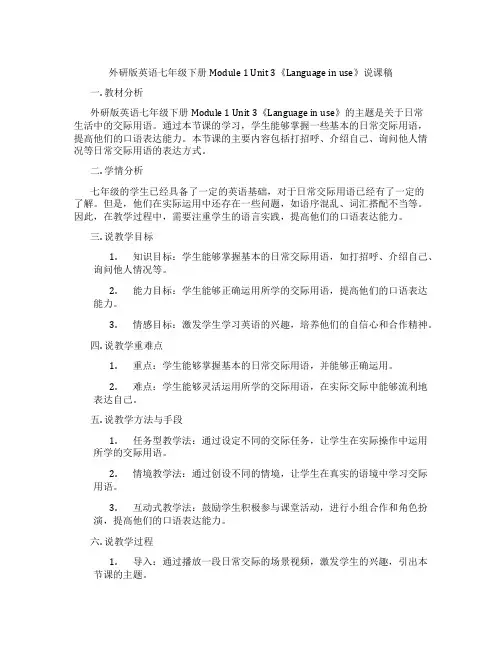
外研版英语七年级下册Module 1 Unit 3《Language in use》说课稿一. 教材分析外研版英语七年级下册Module 1 Unit 3《Language in use》的主题是关于日常生活中的交际用语。
通过本节课的学习,学生能够掌握一些基本的日常交际用语,提高他们的口语表达能力。
本节课的主要内容包括打招呼、介绍自己、询问他人情况等日常交际用语的表达方式。
二. 学情分析七年级的学生已经具备了一定的英语基础,对于日常交际用语已经有了一定的了解。
但是,他们在实际运用中还存在一些问题,如语序混乱、词汇搭配不当等。
因此,在教学过程中,需要注重学生的语言实践,提高他们的口语表达能力。
三. 说教学目标1.知识目标:学生能够掌握基本的日常交际用语,如打招呼、介绍自己、询问他人情况等。
2.能力目标:学生能够正确运用所学的交际用语,提高他们的口语表达能力。
3.情感目标:激发学生学习英语的兴趣,培养他们的自信心和合作精神。
四. 说教学重难点1.重点:学生能够掌握基本的日常交际用语,并能够正确运用。
2.难点:学生能够灵活运用所学的交际用语,在实际交际中能够流利地表达自己。
五. 说教学方法与手段1.任务型教学法:通过设定不同的交际任务,让学生在实际操作中运用所学的交际用语。
2.情境教学法:通过创设不同的情境,让学生在真实的语境中学习交际用语。
3.互动式教学法:鼓励学生积极参与课堂活动,进行小组合作和角色扮演,提高他们的口语表达能力。
六. 说教学过程1.导入:通过播放一段日常交际的场景视频,激发学生的兴趣,引出本节课的主题。
2.呈现:教师通过展示图片、实物等,呈现本节课的主要交际用语,并引导学生进行观察和思考。
3.操练:学生分组进行角色扮演,模拟不同的日常交际场景,运用所学的交际用语进行练习。
4.互动:学生进行小组合作,共同完成一项交际任务,如制作一个简单的对话场景,进行展示。
5.巩固:学生进行听力练习,听懂并模仿所学的交际用语。

外研版英语七年级下册Module 5 Unit 1《What can I do for you》教学设计一. 教材分析外研版英语七年级下册Module 5 Unit 1的主题是“What can I do for you”,主要介绍日常生活中的一些服务场所和相应的服务用语。
通过本节课的学习,学生能够掌握一些基本的日常用语,提高他们的语言交际能力。
本节课的内容贴近学生的生活,有利于激发他们的学习兴趣。
二. 学情分析七年级的学生已经掌握了一些基本的英语语法和词汇,具备一定的听说读写能力。
但是,他们的语言运用能力还不够成熟,需要在日常教学中不断进行锻炼和提高。
此外,学生的学习兴趣和积极性对他们的学习效果有很大的影响,因此,在教学过程中,教师应注重激发学生的学习兴趣,提高他们的学习积极性。
三. 教学目标1.知识目标:学生能够掌握日常生活中的一些基本服务用语,如“Whatcan I do for you?”、“Here you are.”等。
2.能力目标:学生能够在日常生活中运用所学知识进行简单的交流,提高他们的语言交际能力。
3.情感目标:通过本节课的学习,学生能够培养对英语学习的兴趣,增强自信心。
四. 教学重难点1.重点:学生能够掌握日常生活中的一些基本服务用语,并能在实际情境中进行运用。
2.难点:学生能够正确使用疑问词“What”进行询问,并能够根据实际情况进行回答。
五. 教学方法1.情境教学法:通过设定各种真实的生活情境,让学生在实际语境中学习和服务用语,提高他们的语言交际能力。
2.任务型教学法:通过完成各种任务,激发学生的学习兴趣,提高他们的学习积极性。
3.互动式教学法:通过教师与学生、学生与学生之间的互动,促进知识的传递和语言技能的培养。
六. 教学准备1.教学课件:制作与本节课内容相关的课件,包括图片、动画、视频等,以便在课堂上进行展示。
2.教学素材:准备一些与日常生活服务场所相关的图片、卡片等,用于教学过程中的展示和练习。
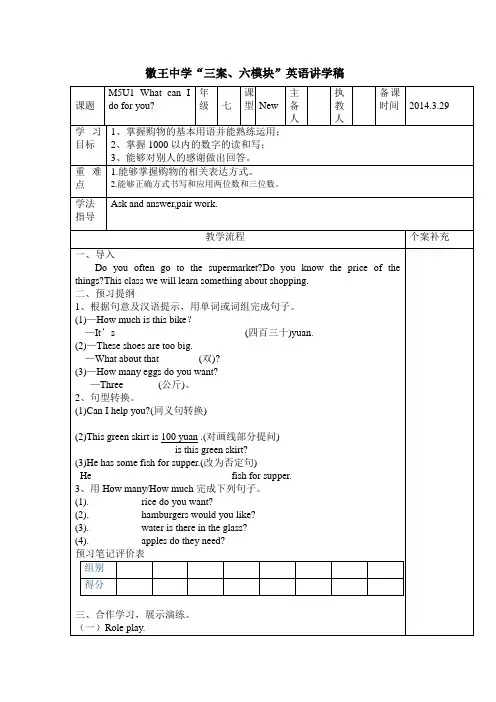
徽王中学“三案、六模块”英语讲学稿课题M5U1 What can Ido for you?年级七课型New主备人执教人备课时间2014.3.29学习目标1、掌握购物的基本用语并能熟练运用;2、掌握1000以内的数字的读和写;3、能够对别人的感谢做出回答。
重难点1.能够掌握购物的相关表达方式。
2.能够正确方式书写和应用两位数和三位数。
学法指导Ask and answer,pair work.教学流程个案补充一、导入Do you often go to the supermarket?Do you know the price of thethings?This class we will learn something about shopping.二、预习提纲1、根据句意及汉语提示,用单词或词组完成句子。
(1)—How much is this bike?—It’s _________________________ (四百三十)yuan.(2)—These shoes are too big.—What about that________(双)?(3)—How many eggs do you want?—Three_______(公斤)。
2、句型转换。
(1)Can I help you?(同义句转换)_______________________________________________(2)This green skirt is 100 yuan .(对画线部分提问)________ __________is this green skirt?(3)He has some fish for supper.(改为否定句)He________ ________ ________fish for supper.3、用How many/How much完成下列句子。
(1).__________ rice do you want?(2).__________ hamburgers would you like?(3).__________ water is there in the glass?(4).__________ apples do they need?预习笔记评价表组别得分三、合作学习,展示演练。
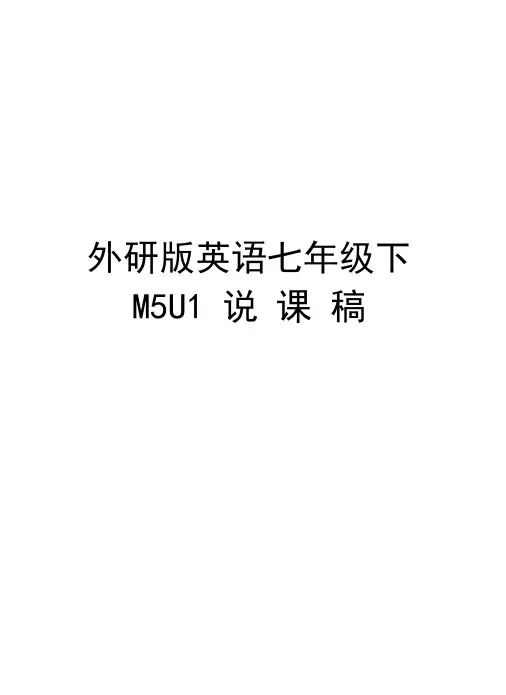
外研版英语七年级下M5U1 说课稿外研社七年级下英语说课稿Module 5 Unit 1 What can I do for you? 杨芳说课的的内容:一、说教材二、说教法三、说学法四、说教学程序一、说教材1.教材分析本单元的核心教学内容是以购物为主体,引导学生掌握关于购物的新词汇,同时掌握What Can I do for you? HoW much is it?和that' too expe nsive等的表达方式,以及在购物过程中讨价还价的英语表达方式。
使学生在掌握语言结构的同时,增强课堂积极性;同时也增强学习的兴趣和效果。
在以What are you going to do at the Weekenet?! 话题引出go ShOPPing这一主题。
第一部分内容是认识新单词,掌握关于购物的词汇。
第二部分是对学生听力的训练。
第三部分是对学生所掌握知识的拓展运用(情景表演)2.教学重点(1) 指导学生掌握和熟练运用关于购物的词汇,如Mother's Day, size,take, may, try, try on, Certai nly, sale, price, look, fresh 等词汇以及句型结构What Can I do for you?——I' like tobuy∙∙∙/ What size- / What colour- / How much …和HOWmany …”等。
(2)指导学生口头熟练表达关于购物以及在购物过程中讨价还价的对话内容,包括第二部分的对话巩固。
(3)W hat Can I do for you?和HoW much is it?/ What Colour••?/ What SiZe…?等句型的熟练掌握运用。
3.教学难点学生根据实际情境需要真正开口讲英语。
4.教学目标(1)技能目标。
学生能听懂本对话录音,能听懂师生之间就本对话内容而展开的问答,会和别人展开对话,了解和传递信息;能就类似话题,创造性地自编对话;掌握表示有What Can I do for you?'句型。
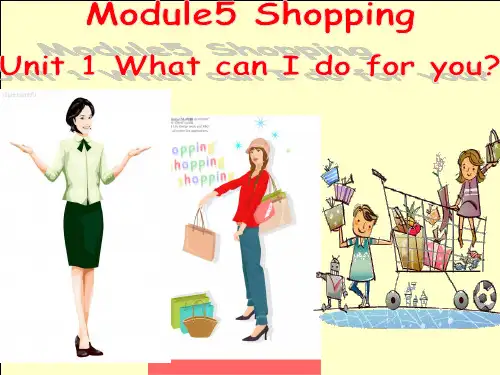

外研版七下英语M5讲义外研版英语七年级下册第5模块讲义5.Would you like to (邮寄)me a picture when you get to Shanghai?智能梳理Module 5 Shopping一、学习目标:A.单词和短语:market, supermarket, biscuit, lemon, strawberry, Mother’s Day, size, take, may, try, try on, certainly, wait a minute, sale, price, look, fresh, advantage, anyone, anything, anywhere, compare, pay, post, product, receive, safe, several, online, shopping, way, one of… almost, open, later, out, go out, over, one day, oneB.交际用语:1. Can I help you? / What can I do for you?2. I’d like to buy a T-shirt for my mum.3. — What colour does she like? — Purple.4. — What size does she take? — Small.5. — May I try it on? — Certainly.6. There’s a sale on today. Everything is half price.7. OK! I’ll take it.8. Wait a minute!9. How many / much would you like?Unit 1 What can I do for you?ⅠTeaching modelListening and speakingⅢTeaching aims1. To understand conversations.2. Talking about going shopping.3. Questions: What…? How many / much…?ⅣTeaching Objectives1. Key vocabulary: market, superma rket, biscuit, lemon, strawberry, Mother’s Day,size, take, may, try, try on, certainly, wait a minute, sale, price,look, fresh, advantage2. Key structures: 1) Can I help you? / What can I do for you?2) I’d like to buy….3) — What colour does she like? — Purple.4) — What size does she take? — Small.5) — May I try it on? — Certainly.6) There’s a sale on today. Everything is half price.7) OK ! I’ll take it.8) Wait a minute!9) How many / much would you like?Unit 2 You can buy everything on the Internet.Around the world: Catalogue shopping1. Ask the students to look at the picture and discuss what they can see.2. Read through the information with the whole class.3. 根据“Around the world”中的信息,补全下列句子:1) There are many ________ _______ in America today.2) _________ _________ is one of the popular ways.3) You can buy almost ______________ you need.4) Many people order their _________ and __________ from catalogues.书面表达:周六,你和同班同学打算去野炊,你们带了很多食物(如:面包、饼干、肉、鸡蛋和蔬菜等)、水果(如:苹果、桔子和草莓等)和饮料(如牛奶、果汁和水)。
Module 5 my hometown and countryUnit 1 Shanghai is bigger than Hong Kong.教案一.Teaching aims and demands1.Master the words:hometown than east south kilometer metre high million busy coast hill island population answer puestion2.To understand the conversations involving the comparison of two cities.3..To talk about two different cities or rivers.二、Grasp the key words and key structure:1.Hong Kong is smaller than Shanghai.Is Shanghai newer than Hong Kong?No, it isn’t. It’s older.(重点)2.Listening skill: To understand conversations involving the comparison of 2 cities. (难点)3.Affection: We should love our hometown and country.课前延伸1.预习单词,根据音标熟练读出单词,掌握汉语意思。
hometown,than,east,south,kilometer,metre,high,million,busy,coast,hill,island,population,answer,puestion2.翻译以下短语:East China South China the Band Victoria Peak 1.5 kilometres long 554 metres high 13 milliom people 7 million people3.查阅上海和香港的有关资料。
Module5 Unit1 教案ⅠTeaching modelListening and speakingⅡTeaching methodBottom-up approach to listeningⅢTeaching aims1. To understand conversations.2. Talking about going shopping.3. Questions: What…? How many / much…?ⅣTeaching Objectives1. Key vocabulary: market, supermarket, biscuit, lemon, strawberry,Mother’s Day, size, take, may, try, try on,certainly, wait a minute, sale, price, look, fresh,advantage2. Key structures: 1) Can I help you? / What can I do for you?2) I’d like to buy….3) — What colour does she like? — Purple.4) — What size does she take? — Small.5) — May I try it on? — Certainly.6) There’s a sale on today. Everything is half price.7) OK ! I’ll take it.8) Wait a minute!9) How many / much would you like?ⅤTeaching aidsTape recorder, OHP, videoⅥTeaching StepsStep 1 Warming up1. Show some pictures of school things. Say what they are.2. Read the words after the teacher.3. Introduce the new words.Step 2 Work in pairs.1. Ask the students to read the words in Activity 1.clothes shop market supermarket2. Look at the pictures carefully in Activity 1.3. Match the words and e the box with the pictures.4. Check their answer with a partner.5. Call back the answer from the whole class and check the answer.6. Ask the students to read the words.biscuit lemon sausage strawberry T-shirt7. Say where you can buy these things.Step 3 Listen and answer the questions.1. Ask the students to read the questions in Activity2.1) What is Lingling going to buy for her mother on Mother’s Day?2) What is Betty going to make for her mother?3) What does Betty want to buy?4) When are they going to the shops?2. Play the recording and ask the students to listen to the recording carefully.3. Listen and answer the questions.4. Play the recording again, then they can check their answer witha partner.5. Call back the answer from the whole class and check the answer. Step 4 Listen and read.1. Ask the students to read the conversation silently.2. Play the recording and ask the students to listen and read the conversation.3. Read the conversation.4. Act it out.5. Learn “Everyday English”Certainly.Wait a minute!Can I help you?6. Learn to learnYou don’t have to understand every word when you listen. Try to listen for the important information.Step 5 Complete the table.1. Read the conversation again.2. Now complete the table.3. Ask the students to check with a partner.4. Play the recording again .Check the answers:Keys: 1. one 2. 99 yuan 3. half a kilo 4. 19 yuan 5. one kilo 6. 10 yuanStep 6 Complete the conversation.1. Ask the students to read the words in the box in Activity 4.2. Read through the conversation.1) The strawberries look very __________ and the ___________ is only ten yuan a kilo. __________ is so cheap!2) —This is my ____________. Can I try it on?— ______________. The clothes are ___________ price today.3. Complete the sentences with the correct form of the words from the box.4. Ask the students to check with a partner.5. Check the answers:Keys: 1. fresh, price, Everything 2. size, Certainly, half6. Read the conversation loudly.Step 7 Listen and repeat.1. Play the recording once without stopping.2. Play the recording again and stop at the end of each line. Ask the whole class to repeat.3. Play the recording again and stop at the end of each line. Ask individual students to repeat.4. Ask the students to practice the sounds in pairs.Step 8 Guessing game.1. Show some pictures.2. Ask and answer:1) What colour is it?2) What size do you take?3) How much is it?3. Show some pictures..4. According to the information given and ask the students to guess what it is.5. Show the pictures to check the answers.Step 9 Work in pairs.Student A: You’re a customer. Buy a present for a family member or a friend. Use the sentences in Everyday English and Activity 3 to help you.Student B: You’re a shop worker. Help Student A buy a present for his / her family member or friend.Step 10 Summary:表示购物的习惯用语:May / Can I help you?How many / much would you like?What colour / size would you like?I want / I'd like…How much is it / are they?That's too e afraid.Do you have any other colours / sizes / kinds?That's fine. I'll take it.Step 11 Do e going to buy for my mother on __________(母亲)Day2. My brother likes eating __________(草莓).3. There’s a __________(降价) on today.4. Everything is half __________(价格).5. What __________(别的) would you like?Keys: 1. Mother’s 2. strawberries 3. sale 4. price5. else二、补全对话:1. — ________ can I do ________ you?—I’d like to buy a T-shirt for my son.2. — ______________ does he like?— He likes white.3. — _______________ do you like?— Small.4. —May I try it on ?—___________________________.5.—_______________ would you like?— Half a kilo.6. —_______________are they?—Thirty-eight yuan kilo.7. —_______________ lemons are there on the table?—There are seven lemons on the table.Keys:1. What can I do for you?2. What colour3. What size4. Certainly / Sure / OK/ Of course.5. How much6. How much7. How manyStep 12 HomeworkRemember the words of Unit 1 and prepare the text of Unit 2.。
外研版英语七年级下M5U1说课稿
外研社七年级下英语说课稿Module 5 Unit 1 What can I do for you?
杨芳
说课的的内容:
一、说教材二、说教法三、说学法四、说教学程序
一、说教材
1.教材分析
本单元的核心教学内容是以购物为主体,引导学生掌握关于购物的新词汇,同时掌握“what can I do for you? How much is it?和that’s too expensive等的表达方式,以及在购物过程中讨价还价的英语表达方式。
使学生在掌握语言结构的同时,增强课堂积极性;同时也增强学习的兴趣和效果。
在以what are you going to do at the weekend?为话题引出go shopping 这一主题。
第一部分内容是认识新单词,掌握关于购物的词汇。
第二部分是对学生听力的训练。
第三部分是对学生所掌握知识的拓展运用(情景表演)
2.教学重点
(1) 指导学生掌握和熟练运用关于购物的词汇,如Mother’s Day, size, take, may, try, try on, certainly, sale, price, look, fresh 等词汇以及句型结构“What can I do for you?-----I’d like to buy…/ What size…/ What colour…/ How much…和How many…”等。
(2) 指导学生口头熟练表达关于购物以及在购物过程中讨价还价的对话内容,包括第二部分的对话巩固。
(3) What can I do for you? 和How much is it?/ What colour…?/ What size…?等句型的熟练掌握运用。
3.教学难点
学生根据实际情境需要真正开口讲英语。
4.教学目标
(1) 技能目标。
学生能听懂本对话录音,能听懂师生之间就本对话内容而展开的问答,会和别人展开对话,了解和传递信息;能就类似话题,创造性地自编对话;掌握表示“有 what can I do for you?”句型。
(2) 知识目标。
学生要牢记所有该课新单词,,还要记住新学短语、句型、难句及本课对话各句的英语表达,为实现自如讲英语奠定基础。
(3) 情感目标。
学生要爱学英语、爱说英语、想说语,对英语学习投以极大的兴趣和热情。
并且通过对课文内容的理解去关爱父母,懂得感恩。
(4)学习策略目标。
改变传统的死记硬背,积极主动地投入到语言的实践中去,包括听、说、读、写的实践。
在实践中提高语言的综合使用能力,加深对基础知识的掌握和记忆。
二、说教法
为了充分以学生为主体的课堂教学,并考虑到学生认知特点和年龄特征,对本课我主要采取了如下几种教法::
1.听录音.
听音是英语学习的重要方法,也是课堂教学的重要步骤。
在听中可以感知,可以模仿。
2.重点解释,个别操练.
在每一堂教学中,学生总会遇到一些难以理解的词、句型、短语、句子或某一语法现象。
如本课出现的“What can I do for you? …/ What colour…?/ What size…/ That’s too much ”句型的用法等都需要教师个别解释甚至创设语言情境进行操练和举例,以扫除自由交际过程中的“拦路虎”,为语言的进一步学习奠定基础。
3.指导学生展开情景对话。
师生完全可以根据当时的实际思路创造性地交流,这种教法是实现语言知识向语言能力转变的必经之路。
5.学生独立操作。
首先要求学生根据师生示范独立对话,随后叫几组分别站起来表演。
这是深化课堂教学的重要举措。
6.教师可设计填空或完成句子,以检查学生对本对话的掌握情况。
三、说学法
我所采用的任务型教学法有助于学生掌握如下学法:
1.养成听的习惯。
学生要经常听录音,听教师讲英语,听同学们讲英语,这对学好英语大有好
2.科学储备大量知识。
学生不掌握丰富的知识就不可能进行很好的语言交流。
要学会在实践中学,在应用中学,这样学来的知识记忆深刻、灵活度大。
3.及时巩固,反复记忆。
凡教师在课堂上所讲到的语言难点,学生应及时整理,并记录再次认识并积极使用。
对前面已学过的课文,学生要有安排地经常复习,否则常常是学了新的,忘了旧的。
4.积极操练,重在口头。
在课堂上,学生要积极参与教师设计的每个教学活动,要大胆开口,创造性地说自己想说的话。
课后和其他同学及时进行英语交流。
只有这样,才能将书本知识变成自己的知识和语言能力;也只有这样,才能实现脱口说英语的目的。
四.说教学程序
1.引入
提出问题,让学生对上节课的内容进行巩固。
如“What are you going to do at the weekend? What things are you going to buy? Where are you going to buy these things? ”令学生轻松地来到英语课堂上来,在课前让学生全部做热身运动.
2.单词呈现
由于我希望学生能在课堂上多点操练的机会,所以我事先在早读课就让学生基本掌握了本课的新单词。
在本节课的一开始就让学生根据图片说出新单词,并且以读单词又快又准为奖励方法的形式让学生在游戏比赛中回忆并牢记该课单词。
如:I can buy T-shirt, dress, trousers in clothes shop; I can buy biscuits, strawberries, lemons, apples, grapes in market; I can buy sausage, milk, lemons, strawberries, biscuits in supermarket.
3. 听读训练
教师先领读,学生读完后,在合着书本的情况下再听一遍课文并回答问题:
“What size does Lingling’s mother take?”“How much is the T-shirt?”4.重读课文并分析文章重点句子。
5. 解读听力材料,就重要词汇或短语进行解读分析,并扩展运用对话训练。
6.巩固验收。
(1) 完成表格。